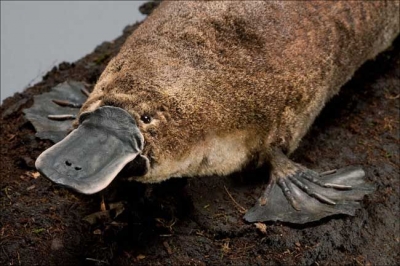
Platypus, also called duckbill, a small amphibious Australian mammal noted for its odd combination of primitive features and special adaptations, especially the flat, almost comical bill that early observers thought was that of a duck sewn onto the body of a mammal. Adding to its distinctive appearance are conspicuous white patches of fur under the eyes. The fur on the rest of the body is dark to light brown above, with lighter fur on the underside.
The platypus is common in waterways of eastern Australia, where it generally feeds on bottom-dwelling invertebrates but also takes an occasional frog, fish, or insect at the water’s surface. This shy creature forages most actively from dusk to dawn, sheltering during the day in burrows dug into stream banks. It is exquisitely adapted for its aquatic lifestyle, having a flattened torpedo-like body, dense waterproof fur, and strong front limbs used for swimming as well as digging. Even the head is streamlined, each ear being housed in a groove together with a small eye. The senses of sight, smell, and hearing are essentially shut down while the platypus is submerged to feed, but it possesses a unique electromechanical system of electroreceptors and touch receptors that allow it to navigate perfectly underwater. Similar electroreceptors are also present in echidnas, which, together with the platypus, make up the mammalian order Monotremata, a unique group with an exceptionally ancient history.
Platypuses range in length from 38 to 60 cm (15 to 24 inches); males are generally larger than females. Aquatic adaptations include the flat streamlined body, dorsally placed eyes and nostrils, and dense waterproof fur that keeps the platypus well insulated. Long guard hairs protect the soft underfur, which remains dry even after hours in the water.
Credit : Britannica
Picture Credit : Google




